Understanding and Leading Change in Business Operations Report
VerifiedAdded on 2020/10/05
|14
|3843
|320
Report
AI Summary
This report delves into the critical role of change management within the business operations of Starbucks and Costa Coffee. It explores the influence of various change drivers, both internal and external, on leadership styles and individual and team behavior. The report examines how these drivers impact the companies' strategies, with specific examples such as Starbucks' CEO change and technological advancements, and Costa Coffee's Brexit-related challenges. Furthermore, it analyzes the measures undertaken by both companies to mitigate the negative effects of change, including the implementation of models like the Continuous Improvement Model and the PDCA cycle, and system theory. The report emphasizes the importance of adapting to customer needs, technological advancements, and competitive pressures to ensure sustained growth and success in the dynamic market environment. The report provides insights into how these companies have adapted to these changes and the importance of leadership and strategic planning in managing change effectively.
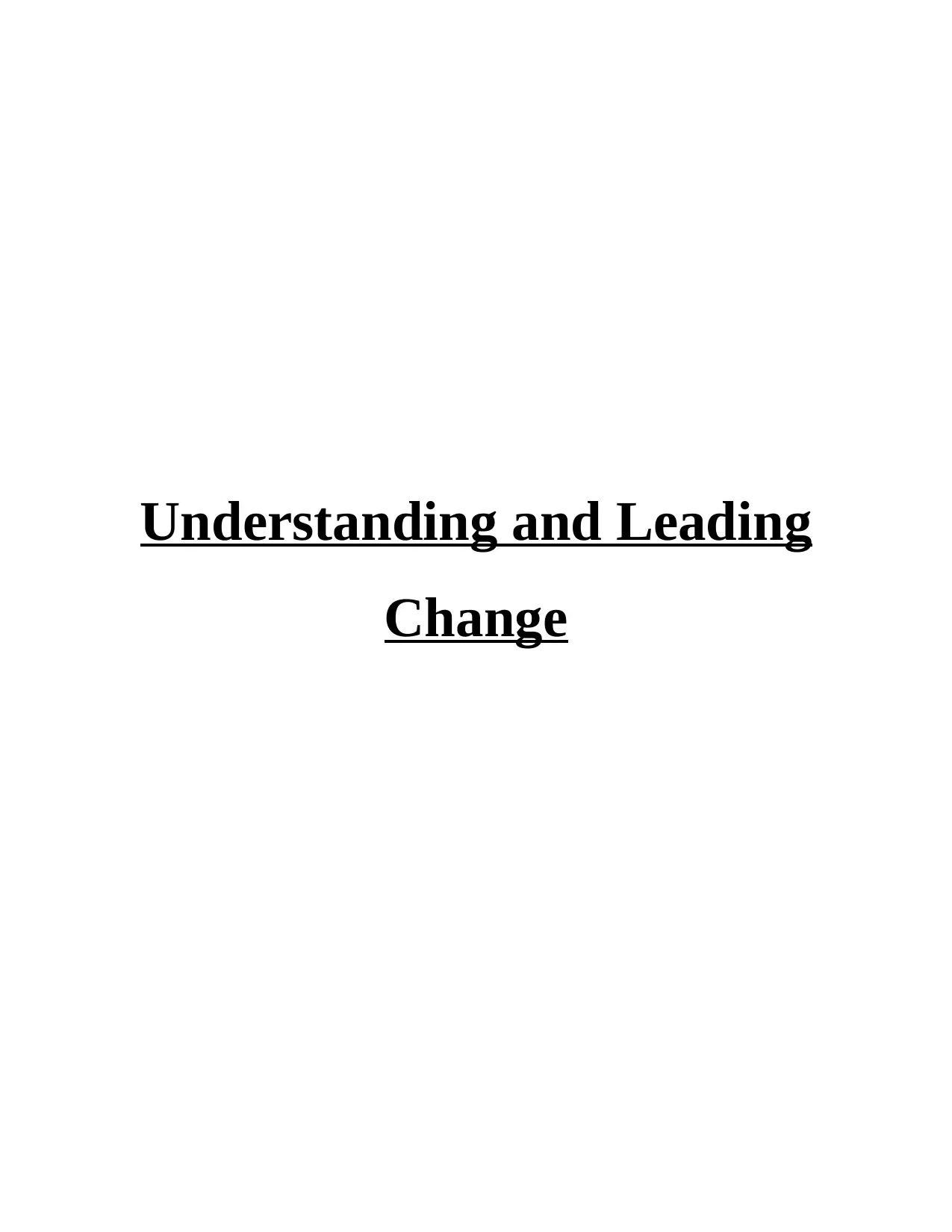
Understanding and Leading
Change
Change
Paraphrase This Document
Need a fresh take? Get an instant paraphrase of this document with our AI Paraphraser
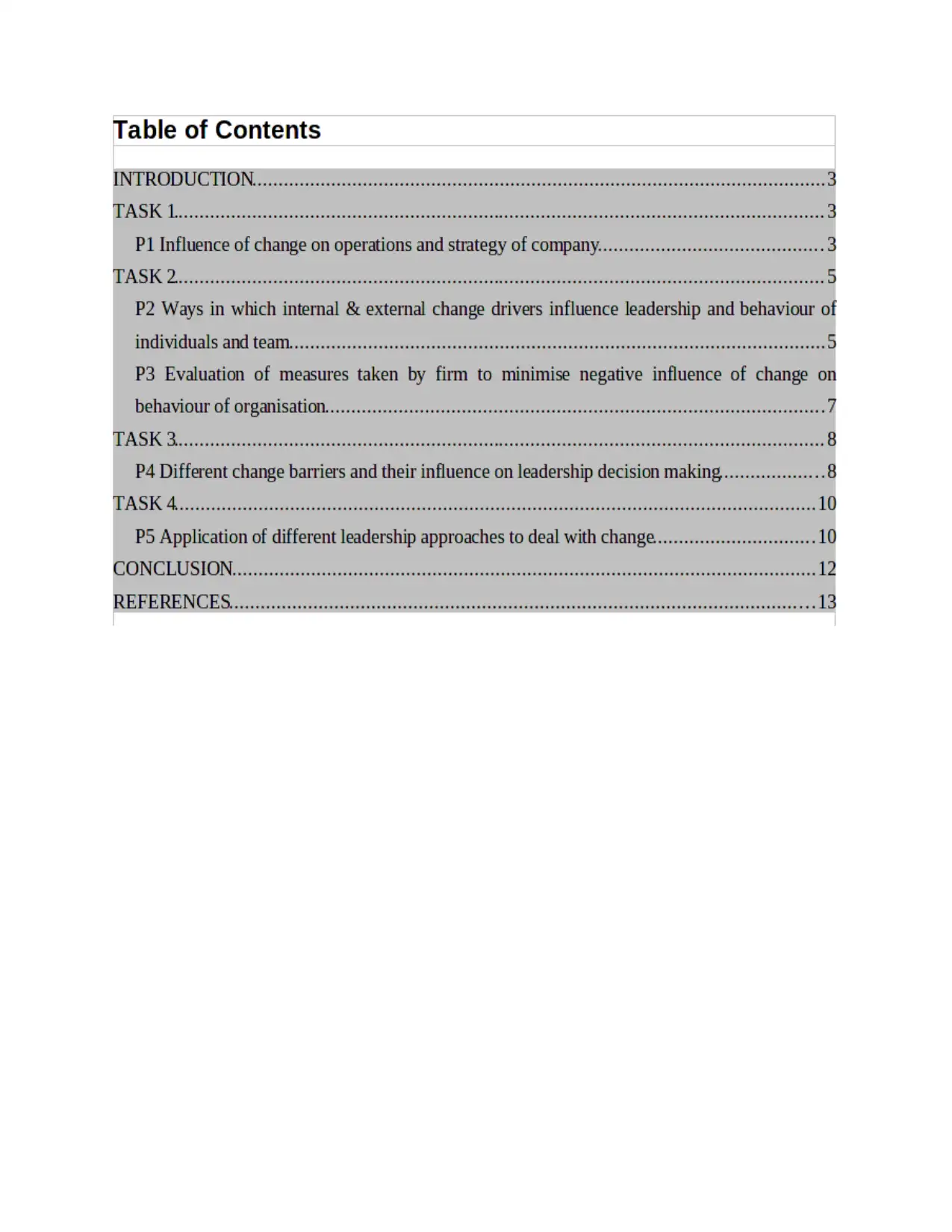
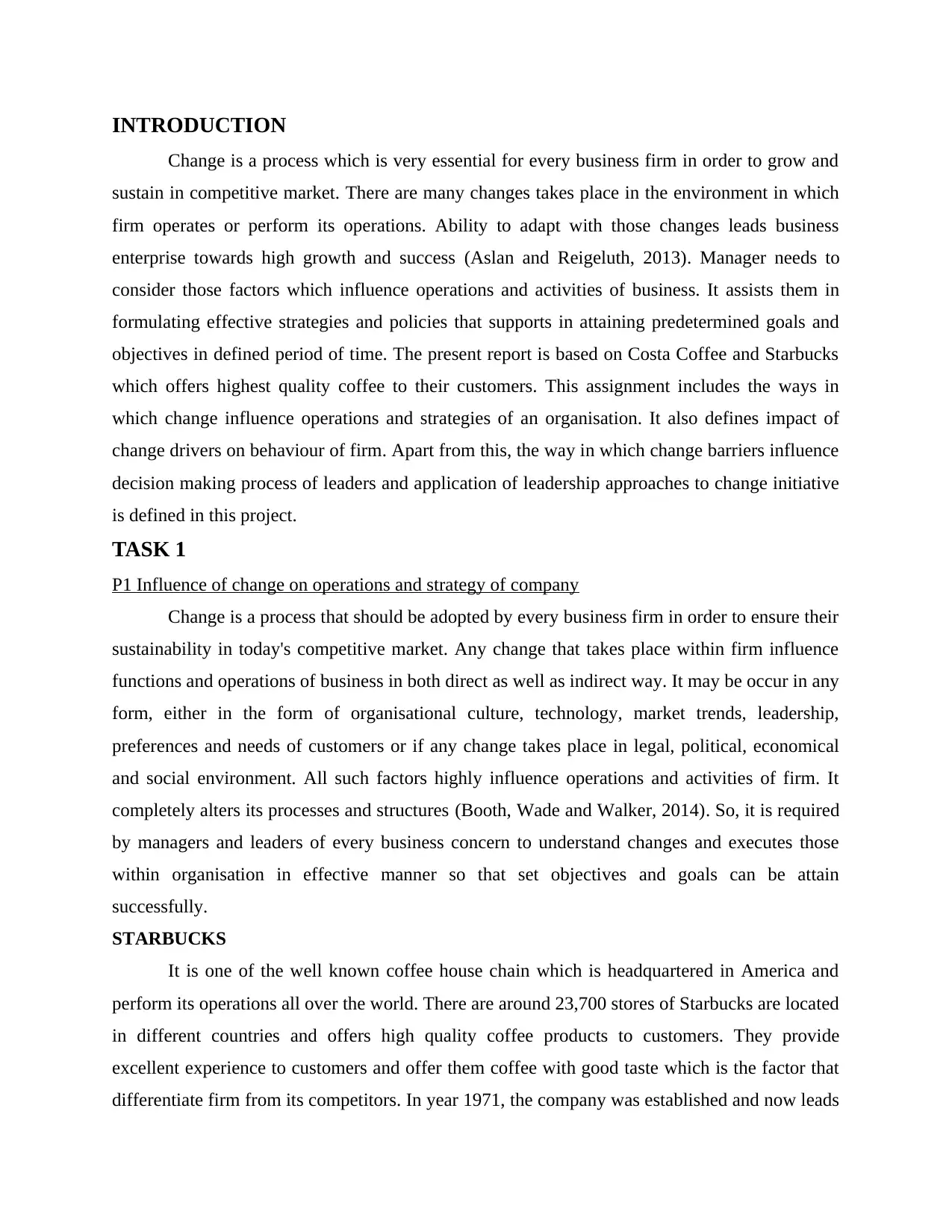
INTRODUCTION
Change is a process which is very essential for every business firm in order to grow and
sustain in competitive market. There are many changes takes place in the environment in which
firm operates or perform its operations. Ability to adapt with those changes leads business
enterprise towards high growth and success (Aslan and Reigeluth, 2013). Manager needs to
consider those factors which influence operations and activities of business. It assists them in
formulating effective strategies and policies that supports in attaining predetermined goals and
objectives in defined period of time. The present report is based on Costa Coffee and Starbucks
which offers highest quality coffee to their customers. This assignment includes the ways in
which change influence operations and strategies of an organisation. It also defines impact of
change drivers on behaviour of firm. Apart from this, the way in which change barriers influence
decision making process of leaders and application of leadership approaches to change initiative
is defined in this project.
TASK 1
P1 Influence of change on operations and strategy of company
Change is a process that should be adopted by every business firm in order to ensure their
sustainability in today's competitive market. Any change that takes place within firm influence
functions and operations of business in both direct as well as indirect way. It may be occur in any
form, either in the form of organisational culture, technology, market trends, leadership,
preferences and needs of customers or if any change takes place in legal, political, economical
and social environment. All such factors highly influence operations and activities of firm. It
completely alters its processes and structures (Booth, Wade and Walker, 2014). So, it is required
by managers and leaders of every business concern to understand changes and executes those
within organisation in effective manner so that set objectives and goals can be attain
successfully.
STARBUCKS
It is one of the well known coffee house chain which is headquartered in America and
perform its operations all over the world. There are around 23,700 stores of Starbucks are located
in different countries and offers high quality coffee products to customers. They provide
excellent experience to customers and offer them coffee with good taste which is the factor that
differentiate firm from its competitors. In year 1971, the company was established and now leads
Change is a process which is very essential for every business firm in order to grow and
sustain in competitive market. There are many changes takes place in the environment in which
firm operates or perform its operations. Ability to adapt with those changes leads business
enterprise towards high growth and success (Aslan and Reigeluth, 2013). Manager needs to
consider those factors which influence operations and activities of business. It assists them in
formulating effective strategies and policies that supports in attaining predetermined goals and
objectives in defined period of time. The present report is based on Costa Coffee and Starbucks
which offers highest quality coffee to their customers. This assignment includes the ways in
which change influence operations and strategies of an organisation. It also defines impact of
change drivers on behaviour of firm. Apart from this, the way in which change barriers influence
decision making process of leaders and application of leadership approaches to change initiative
is defined in this project.
TASK 1
P1 Influence of change on operations and strategy of company
Change is a process that should be adopted by every business firm in order to ensure their
sustainability in today's competitive market. Any change that takes place within firm influence
functions and operations of business in both direct as well as indirect way. It may be occur in any
form, either in the form of organisational culture, technology, market trends, leadership,
preferences and needs of customers or if any change takes place in legal, political, economical
and social environment. All such factors highly influence operations and activities of firm. It
completely alters its processes and structures (Booth, Wade and Walker, 2014). So, it is required
by managers and leaders of every business concern to understand changes and executes those
within organisation in effective manner so that set objectives and goals can be attain
successfully.
STARBUCKS
It is one of the well known coffee house chain which is headquartered in America and
perform its operations all over the world. There are around 23,700 stores of Starbucks are located
in different countries and offers high quality coffee products to customers. They provide
excellent experience to customers and offer them coffee with good taste which is the factor that
differentiate firm from its competitors. In year 1971, the company was established and now leads
⊘ This is a preview!⊘
Do you want full access?
Subscribe today to unlock all pages.

Trusted by 1+ million students worldwide
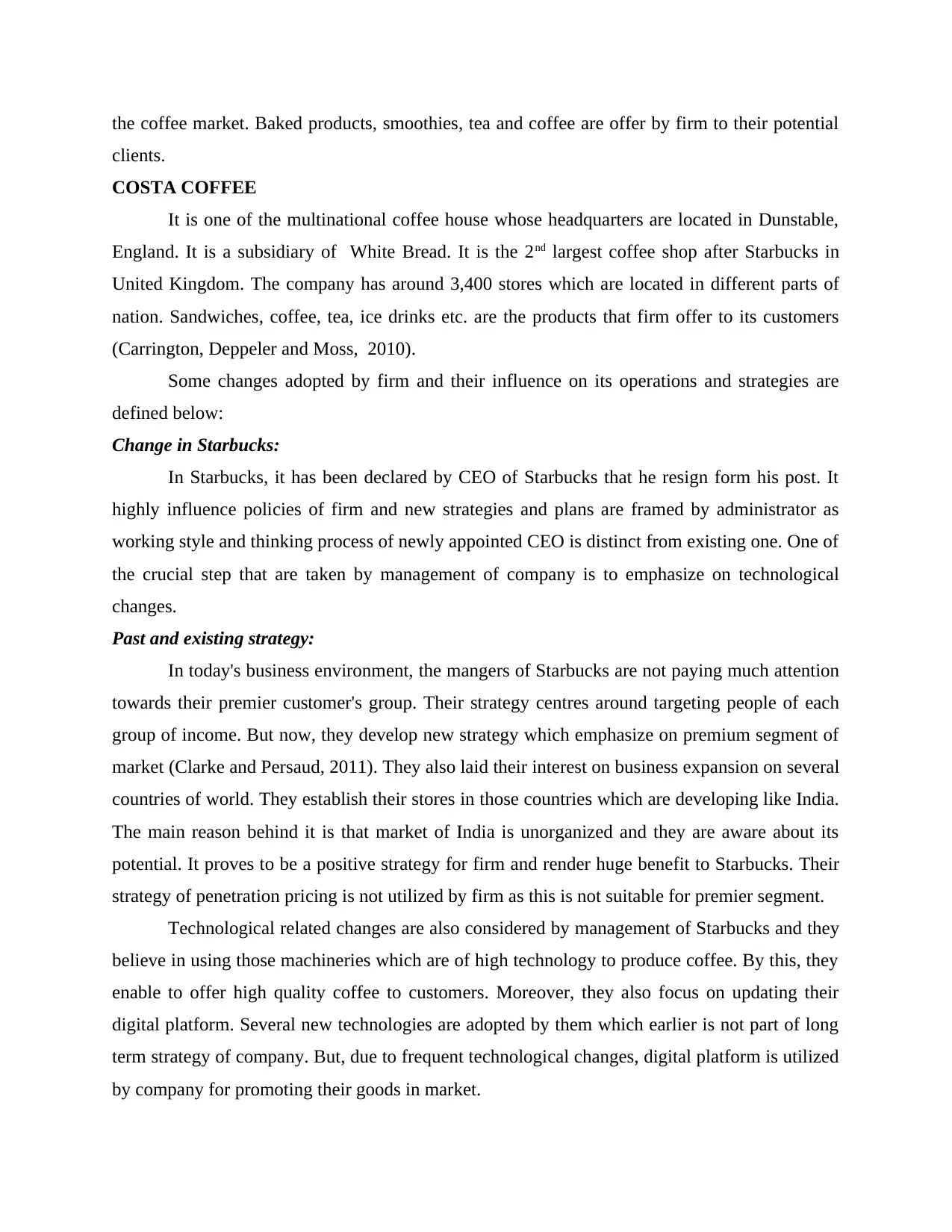
the coffee market. Baked products, smoothies, tea and coffee are offer by firm to their potential
clients.
COSTA COFFEE
It is one of the multinational coffee house whose headquarters are located in Dunstable,
England. It is a subsidiary of White Bread. It is the 2nd largest coffee shop after Starbucks in
United Kingdom. The company has around 3,400 stores which are located in different parts of
nation. Sandwiches, coffee, tea, ice drinks etc. are the products that firm offer to its customers
(Carrington, Deppeler and Moss, 2010).
Some changes adopted by firm and their influence on its operations and strategies are
defined below:
Change in Starbucks:
In Starbucks, it has been declared by CEO of Starbucks that he resign form his post. It
highly influence policies of firm and new strategies and plans are framed by administrator as
working style and thinking process of newly appointed CEO is distinct from existing one. One of
the crucial step that are taken by management of company is to emphasize on technological
changes.
Past and existing strategy:
In today's business environment, the mangers of Starbucks are not paying much attention
towards their premier customer's group. Their strategy centres around targeting people of each
group of income. But now, they develop new strategy which emphasize on premium segment of
market (Clarke and Persaud, 2011). They also laid their interest on business expansion on several
countries of world. They establish their stores in those countries which are developing like India.
The main reason behind it is that market of India is unorganized and they are aware about its
potential. It proves to be a positive strategy for firm and render huge benefit to Starbucks. Their
strategy of penetration pricing is not utilized by firm as this is not suitable for premier segment.
Technological related changes are also considered by management of Starbucks and they
believe in using those machineries which are of high technology to produce coffee. By this, they
enable to offer high quality coffee to customers. Moreover, they also focus on updating their
digital platform. Several new technologies are adopted by them which earlier is not part of long
term strategy of company. But, due to frequent technological changes, digital platform is utilized
by company for promoting their goods in market.
clients.
COSTA COFFEE
It is one of the multinational coffee house whose headquarters are located in Dunstable,
England. It is a subsidiary of White Bread. It is the 2nd largest coffee shop after Starbucks in
United Kingdom. The company has around 3,400 stores which are located in different parts of
nation. Sandwiches, coffee, tea, ice drinks etc. are the products that firm offer to its customers
(Carrington, Deppeler and Moss, 2010).
Some changes adopted by firm and their influence on its operations and strategies are
defined below:
Change in Starbucks:
In Starbucks, it has been declared by CEO of Starbucks that he resign form his post. It
highly influence policies of firm and new strategies and plans are framed by administrator as
working style and thinking process of newly appointed CEO is distinct from existing one. One of
the crucial step that are taken by management of company is to emphasize on technological
changes.
Past and existing strategy:
In today's business environment, the mangers of Starbucks are not paying much attention
towards their premier customer's group. Their strategy centres around targeting people of each
group of income. But now, they develop new strategy which emphasize on premium segment of
market (Clarke and Persaud, 2011). They also laid their interest on business expansion on several
countries of world. They establish their stores in those countries which are developing like India.
The main reason behind it is that market of India is unorganized and they are aware about its
potential. It proves to be a positive strategy for firm and render huge benefit to Starbucks. Their
strategy of penetration pricing is not utilized by firm as this is not suitable for premier segment.
Technological related changes are also considered by management of Starbucks and they
believe in using those machineries which are of high technology to produce coffee. By this, they
enable to offer high quality coffee to customers. Moreover, they also focus on updating their
digital platform. Several new technologies are adopted by them which earlier is not part of long
term strategy of company. But, due to frequent technological changes, digital platform is utilized
by company for promoting their goods in market.
Paraphrase This Document
Need a fresh take? Get an instant paraphrase of this document with our AI Paraphraser
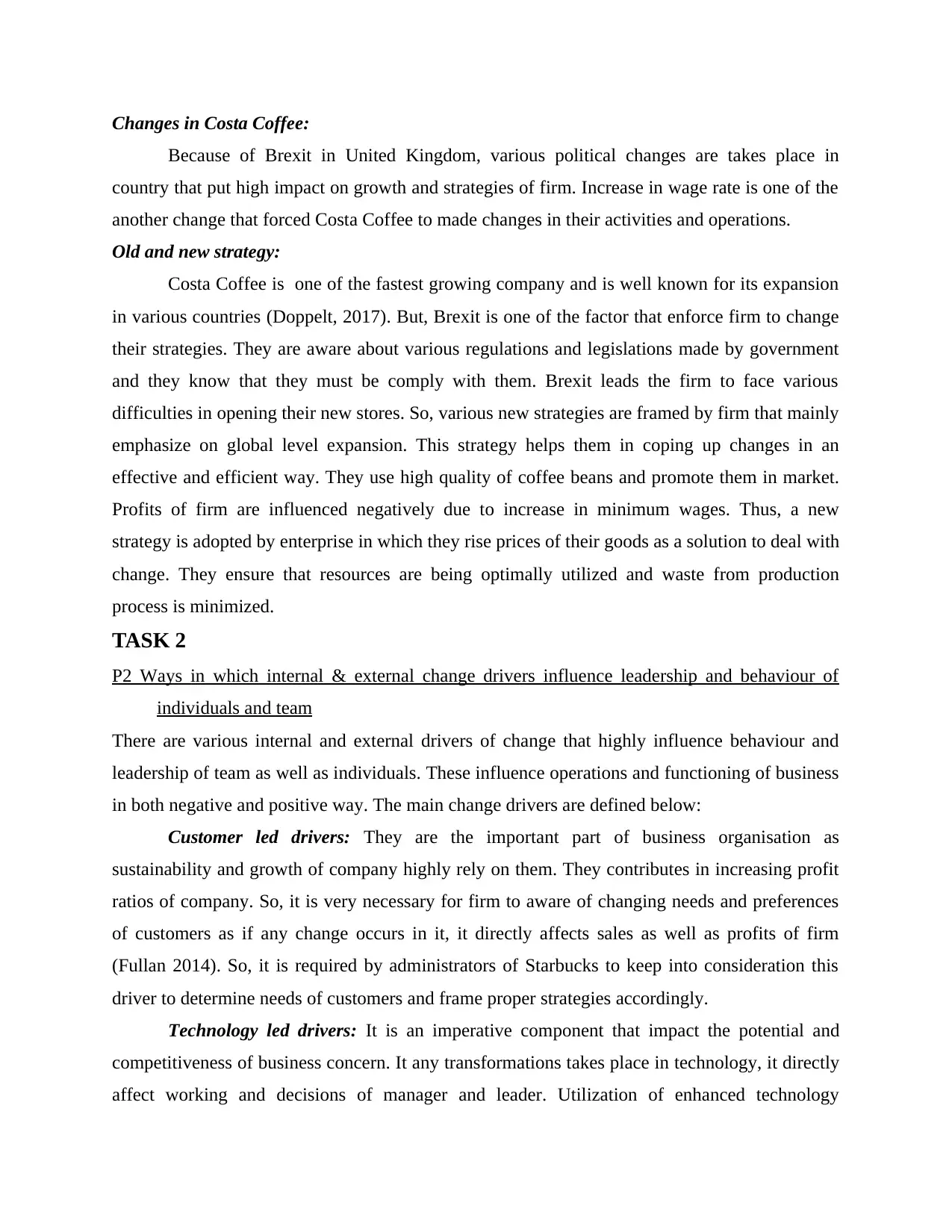
Changes in Costa Coffee:
Because of Brexit in United Kingdom, various political changes are takes place in
country that put high impact on growth and strategies of firm. Increase in wage rate is one of the
another change that forced Costa Coffee to made changes in their activities and operations.
Old and new strategy:
Costa Coffee is one of the fastest growing company and is well known for its expansion
in various countries (Doppelt, 2017). But, Brexit is one of the factor that enforce firm to change
their strategies. They are aware about various regulations and legislations made by government
and they know that they must be comply with them. Brexit leads the firm to face various
difficulties in opening their new stores. So, various new strategies are framed by firm that mainly
emphasize on global level expansion. This strategy helps them in coping up changes in an
effective and efficient way. They use high quality of coffee beans and promote them in market.
Profits of firm are influenced negatively due to increase in minimum wages. Thus, a new
strategy is adopted by enterprise in which they rise prices of their goods as a solution to deal with
change. They ensure that resources are being optimally utilized and waste from production
process is minimized.
TASK 2
P2 Ways in which internal & external change drivers influence leadership and behaviour of
individuals and team
There are various internal and external drivers of change that highly influence behaviour and
leadership of team as well as individuals. These influence operations and functioning of business
in both negative and positive way. The main change drivers are defined below:
Customer led drivers: They are the important part of business organisation as
sustainability and growth of company highly rely on them. They contributes in increasing profit
ratios of company. So, it is very necessary for firm to aware of changing needs and preferences
of customers as if any change occurs in it, it directly affects sales as well as profits of firm
(Fullan 2014). So, it is required by administrators of Starbucks to keep into consideration this
driver to determine needs of customers and frame proper strategies accordingly.
Technology led drivers: It is an imperative component that impact the potential and
competitiveness of business concern. It any transformations takes place in technology, it directly
affect working and decisions of manager and leader. Utilization of enhanced technology
Because of Brexit in United Kingdom, various political changes are takes place in
country that put high impact on growth and strategies of firm. Increase in wage rate is one of the
another change that forced Costa Coffee to made changes in their activities and operations.
Old and new strategy:
Costa Coffee is one of the fastest growing company and is well known for its expansion
in various countries (Doppelt, 2017). But, Brexit is one of the factor that enforce firm to change
their strategies. They are aware about various regulations and legislations made by government
and they know that they must be comply with them. Brexit leads the firm to face various
difficulties in opening their new stores. So, various new strategies are framed by firm that mainly
emphasize on global level expansion. This strategy helps them in coping up changes in an
effective and efficient way. They use high quality of coffee beans and promote them in market.
Profits of firm are influenced negatively due to increase in minimum wages. Thus, a new
strategy is adopted by enterprise in which they rise prices of their goods as a solution to deal with
change. They ensure that resources are being optimally utilized and waste from production
process is minimized.
TASK 2
P2 Ways in which internal & external change drivers influence leadership and behaviour of
individuals and team
There are various internal and external drivers of change that highly influence behaviour and
leadership of team as well as individuals. These influence operations and functioning of business
in both negative and positive way. The main change drivers are defined below:
Customer led drivers: They are the important part of business organisation as
sustainability and growth of company highly rely on them. They contributes in increasing profit
ratios of company. So, it is very necessary for firm to aware of changing needs and preferences
of customers as if any change occurs in it, it directly affects sales as well as profits of firm
(Fullan 2014). So, it is required by administrators of Starbucks to keep into consideration this
driver to determine needs of customers and frame proper strategies accordingly.
Technology led drivers: It is an imperative component that impact the potential and
competitiveness of business concern. It any transformations takes place in technology, it directly
affect working and decisions of manager and leader. Utilization of enhanced technology
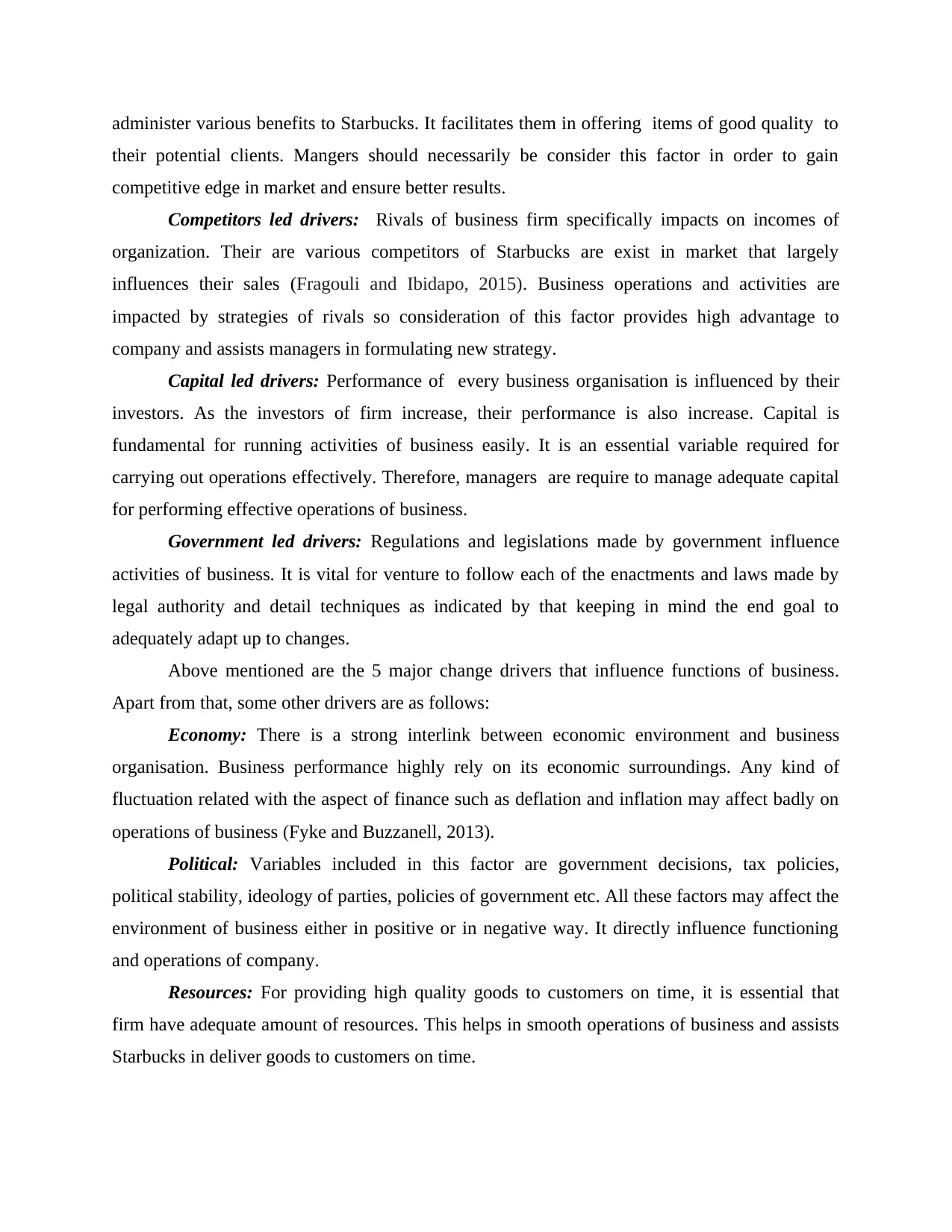
administer various benefits to Starbucks. It facilitates them in offering items of good quality to
their potential clients. Mangers should necessarily be consider this factor in order to gain
competitive edge in market and ensure better results.
Competitors led drivers: Rivals of business firm specifically impacts on incomes of
organization. Their are various competitors of Starbucks are exist in market that largely
influences their sales (Fragouli and Ibidapo, 2015). Business operations and activities are
impacted by strategies of rivals so consideration of this factor provides high advantage to
company and assists managers in formulating new strategy.
Capital led drivers: Performance of every business organisation is influenced by their
investors. As the investors of firm increase, their performance is also increase. Capital is
fundamental for running activities of business easily. It is an essential variable required for
carrying out operations effectively. Therefore, managers are require to manage adequate capital
for performing effective operations of business.
Government led drivers: Regulations and legislations made by government influence
activities of business. It is vital for venture to follow each of the enactments and laws made by
legal authority and detail techniques as indicated by that keeping in mind the end goal to
adequately adapt up to changes.
Above mentioned are the 5 major change drivers that influence functions of business.
Apart from that, some other drivers are as follows:
Economy: There is a strong interlink between economic environment and business
organisation. Business performance highly rely on its economic surroundings. Any kind of
fluctuation related with the aspect of finance such as deflation and inflation may affect badly on
operations of business (Fyke and Buzzanell, 2013).
Political: Variables included in this factor are government decisions, tax policies,
political stability, ideology of parties, policies of government etc. All these factors may affect the
environment of business either in positive or in negative way. It directly influence functioning
and operations of company.
Resources: For providing high quality goods to customers on time, it is essential that
firm have adequate amount of resources. This helps in smooth operations of business and assists
Starbucks in deliver goods to customers on time.
their potential clients. Mangers should necessarily be consider this factor in order to gain
competitive edge in market and ensure better results.
Competitors led drivers: Rivals of business firm specifically impacts on incomes of
organization. Their are various competitors of Starbucks are exist in market that largely
influences their sales (Fragouli and Ibidapo, 2015). Business operations and activities are
impacted by strategies of rivals so consideration of this factor provides high advantage to
company and assists managers in formulating new strategy.
Capital led drivers: Performance of every business organisation is influenced by their
investors. As the investors of firm increase, their performance is also increase. Capital is
fundamental for running activities of business easily. It is an essential variable required for
carrying out operations effectively. Therefore, managers are require to manage adequate capital
for performing effective operations of business.
Government led drivers: Regulations and legislations made by government influence
activities of business. It is vital for venture to follow each of the enactments and laws made by
legal authority and detail techniques as indicated by that keeping in mind the end goal to
adequately adapt up to changes.
Above mentioned are the 5 major change drivers that influence functions of business.
Apart from that, some other drivers are as follows:
Economy: There is a strong interlink between economic environment and business
organisation. Business performance highly rely on its economic surroundings. Any kind of
fluctuation related with the aspect of finance such as deflation and inflation may affect badly on
operations of business (Fyke and Buzzanell, 2013).
Political: Variables included in this factor are government decisions, tax policies,
political stability, ideology of parties, policies of government etc. All these factors may affect the
environment of business either in positive or in negative way. It directly influence functioning
and operations of company.
Resources: For providing high quality goods to customers on time, it is essential that
firm have adequate amount of resources. This helps in smooth operations of business and assists
Starbucks in deliver goods to customers on time.
⊘ This is a preview!⊘
Do you want full access?
Subscribe today to unlock all pages.

Trusted by 1+ million students worldwide
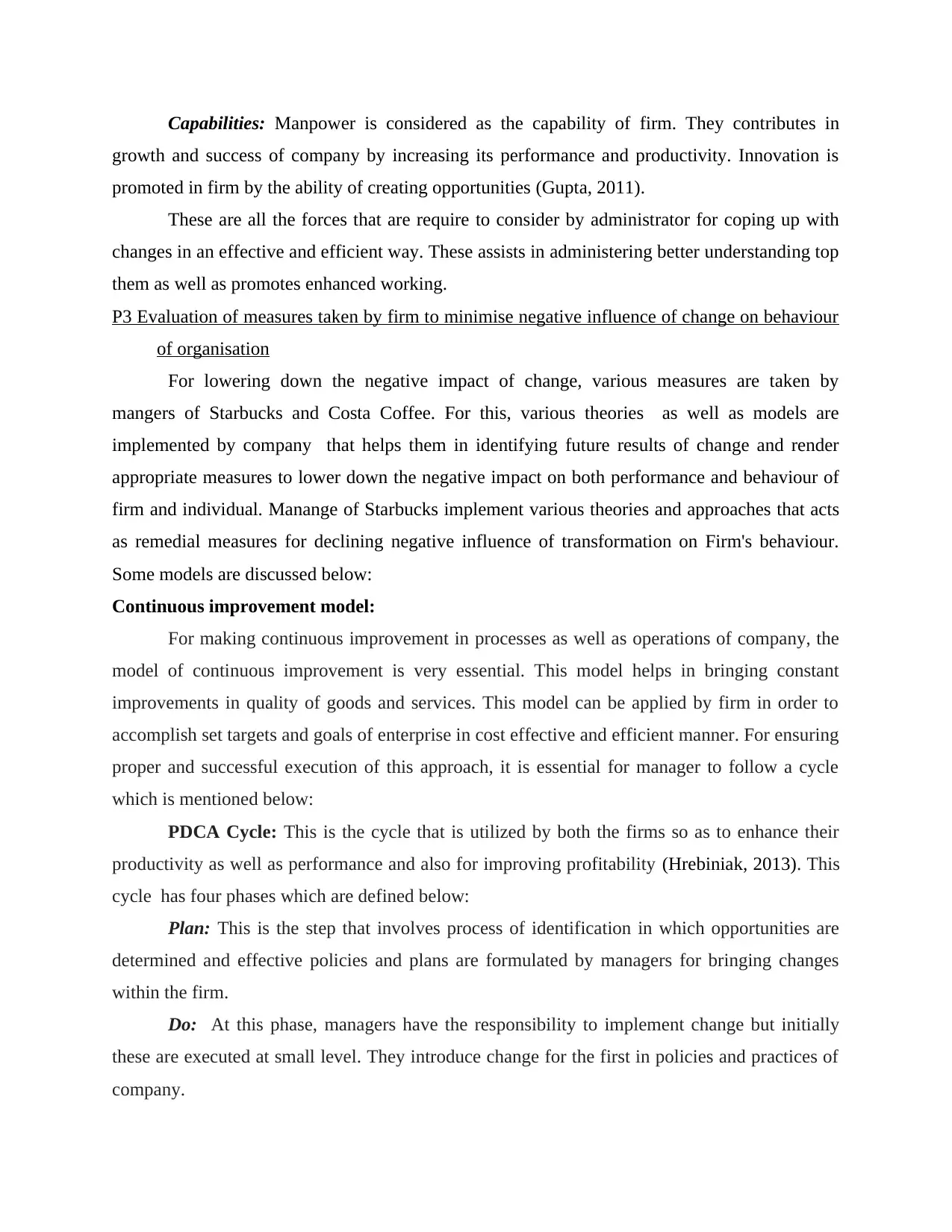
Capabilities: Manpower is considered as the capability of firm. They contributes in
growth and success of company by increasing its performance and productivity. Innovation is
promoted in firm by the ability of creating opportunities (Gupta, 2011).
These are all the forces that are require to consider by administrator for coping up with
changes in an effective and efficient way. These assists in administering better understanding top
them as well as promotes enhanced working.
P3 Evaluation of measures taken by firm to minimise negative influence of change on behaviour
of organisation
For lowering down the negative impact of change, various measures are taken by
mangers of Starbucks and Costa Coffee. For this, various theories as well as models are
implemented by company that helps them in identifying future results of change and render
appropriate measures to lower down the negative impact on both performance and behaviour of
firm and individual. Manange of Starbucks implement various theories and approaches that acts
as remedial measures for declining negative influence of transformation on Firm's behaviour.
Some models are discussed below:
Continuous improvement model:
For making continuous improvement in processes as well as operations of company, the
model of continuous improvement is very essential. This model helps in bringing constant
improvements in quality of goods and services. This model can be applied by firm in order to
accomplish set targets and goals of enterprise in cost effective and efficient manner. For ensuring
proper and successful execution of this approach, it is essential for manager to follow a cycle
which is mentioned below:
PDCA Cycle: This is the cycle that is utilized by both the firms so as to enhance their
productivity as well as performance and also for improving profitability (Hrebiniak, 2013). This
cycle has four phases which are defined below:
Plan: This is the step that involves process of identification in which opportunities are
determined and effective policies and plans are formulated by managers for bringing changes
within the firm.
Do: At this phase, managers have the responsibility to implement change but initially
these are executed at small level. They introduce change for the first in policies and practices of
company.
growth and success of company by increasing its performance and productivity. Innovation is
promoted in firm by the ability of creating opportunities (Gupta, 2011).
These are all the forces that are require to consider by administrator for coping up with
changes in an effective and efficient way. These assists in administering better understanding top
them as well as promotes enhanced working.
P3 Evaluation of measures taken by firm to minimise negative influence of change on behaviour
of organisation
For lowering down the negative impact of change, various measures are taken by
mangers of Starbucks and Costa Coffee. For this, various theories as well as models are
implemented by company that helps them in identifying future results of change and render
appropriate measures to lower down the negative impact on both performance and behaviour of
firm and individual. Manange of Starbucks implement various theories and approaches that acts
as remedial measures for declining negative influence of transformation on Firm's behaviour.
Some models are discussed below:
Continuous improvement model:
For making continuous improvement in processes as well as operations of company, the
model of continuous improvement is very essential. This model helps in bringing constant
improvements in quality of goods and services. This model can be applied by firm in order to
accomplish set targets and goals of enterprise in cost effective and efficient manner. For ensuring
proper and successful execution of this approach, it is essential for manager to follow a cycle
which is mentioned below:
PDCA Cycle: This is the cycle that is utilized by both the firms so as to enhance their
productivity as well as performance and also for improving profitability (Hrebiniak, 2013). This
cycle has four phases which are defined below:
Plan: This is the step that involves process of identification in which opportunities are
determined and effective policies and plans are formulated by managers for bringing changes
within the firm.
Do: At this phase, managers have the responsibility to implement change but initially
these are executed at small level. They introduce change for the first in policies and practices of
company.
Paraphrase This Document
Need a fresh take? Get an instant paraphrase of this document with our AI Paraphraser
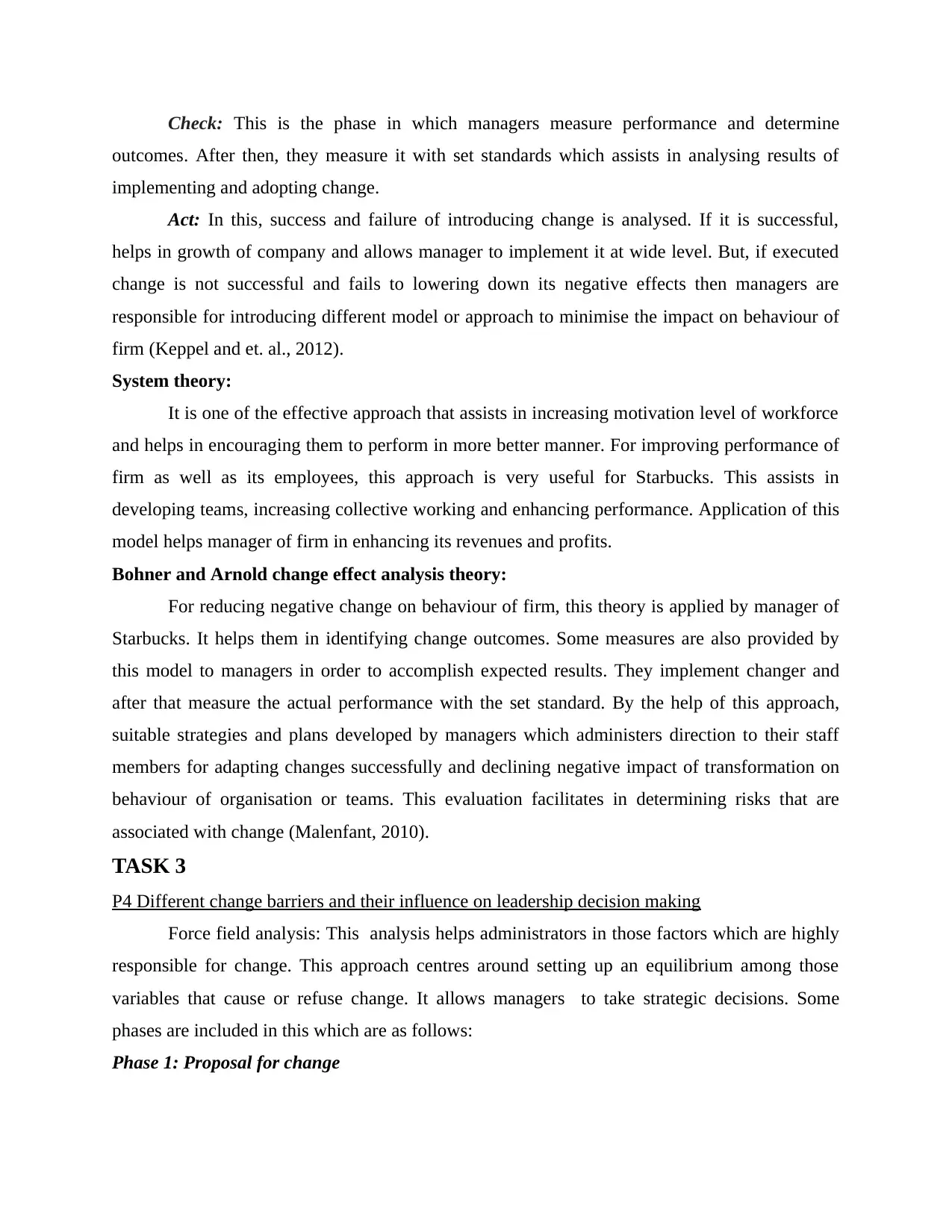
Check: This is the phase in which managers measure performance and determine
outcomes. After then, they measure it with set standards which assists in analysing results of
implementing and adopting change.
Act: In this, success and failure of introducing change is analysed. If it is successful,
helps in growth of company and allows manager to implement it at wide level. But, if executed
change is not successful and fails to lowering down its negative effects then managers are
responsible for introducing different model or approach to minimise the impact on behaviour of
firm (Keppel and et. al., 2012).
System theory:
It is one of the effective approach that assists in increasing motivation level of workforce
and helps in encouraging them to perform in more better manner. For improving performance of
firm as well as its employees, this approach is very useful for Starbucks. This assists in
developing teams, increasing collective working and enhancing performance. Application of this
model helps manager of firm in enhancing its revenues and profits.
Bohner and Arnold change effect analysis theory:
For reducing negative change on behaviour of firm, this theory is applied by manager of
Starbucks. It helps them in identifying change outcomes. Some measures are also provided by
this model to managers in order to accomplish expected results. They implement changer and
after that measure the actual performance with the set standard. By the help of this approach,
suitable strategies and plans developed by managers which administers direction to their staff
members for adapting changes successfully and declining negative impact of transformation on
behaviour of organisation or teams. This evaluation facilitates in determining risks that are
associated with change (Malenfant, 2010).
TASK 3
P4 Different change barriers and their influence on leadership decision making
Force field analysis: This analysis helps administrators in those factors which are highly
responsible for change. This approach centres around setting up an equilibrium among those
variables that cause or refuse change. It allows managers to take strategic decisions. Some
phases are included in this which are as follows:
Phase 1: Proposal for change
outcomes. After then, they measure it with set standards which assists in analysing results of
implementing and adopting change.
Act: In this, success and failure of introducing change is analysed. If it is successful,
helps in growth of company and allows manager to implement it at wide level. But, if executed
change is not successful and fails to lowering down its negative effects then managers are
responsible for introducing different model or approach to minimise the impact on behaviour of
firm (Keppel and et. al., 2012).
System theory:
It is one of the effective approach that assists in increasing motivation level of workforce
and helps in encouraging them to perform in more better manner. For improving performance of
firm as well as its employees, this approach is very useful for Starbucks. This assists in
developing teams, increasing collective working and enhancing performance. Application of this
model helps manager of firm in enhancing its revenues and profits.
Bohner and Arnold change effect analysis theory:
For reducing negative change on behaviour of firm, this theory is applied by manager of
Starbucks. It helps them in identifying change outcomes. Some measures are also provided by
this model to managers in order to accomplish expected results. They implement changer and
after that measure the actual performance with the set standard. By the help of this approach,
suitable strategies and plans developed by managers which administers direction to their staff
members for adapting changes successfully and declining negative impact of transformation on
behaviour of organisation or teams. This evaluation facilitates in determining risks that are
associated with change (Malenfant, 2010).
TASK 3
P4 Different change barriers and their influence on leadership decision making
Force field analysis: This analysis helps administrators in those factors which are highly
responsible for change. This approach centres around setting up an equilibrium among those
variables that cause or refuse change. It allows managers to take strategic decisions. Some
phases are included in this which are as follows:
Phase 1: Proposal for change
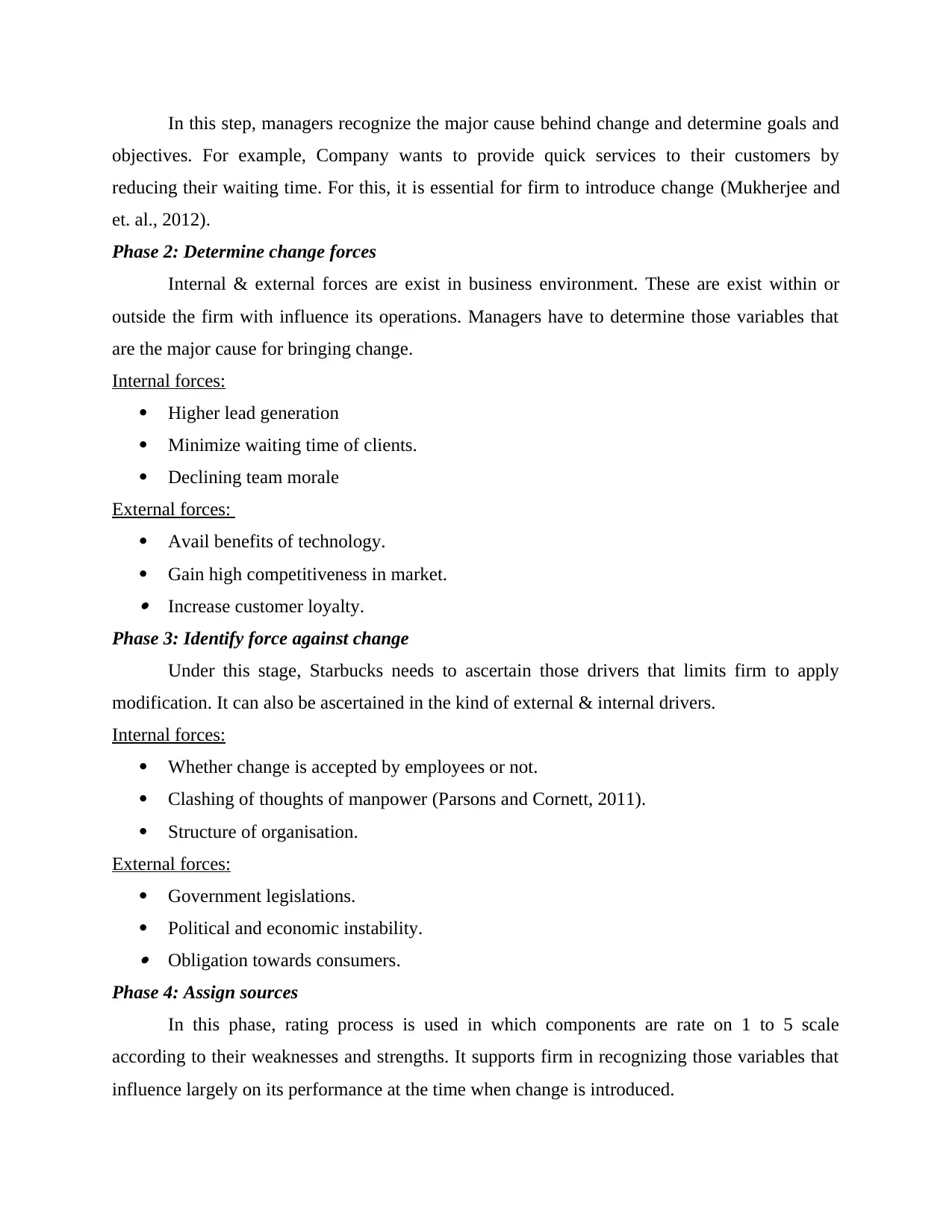
In this step, managers recognize the major cause behind change and determine goals and
objectives. For example, Company wants to provide quick services to their customers by
reducing their waiting time. For this, it is essential for firm to introduce change (Mukherjee and
et. al., 2012).
Phase 2: Determine change forces
Internal & external forces are exist in business environment. These are exist within or
outside the firm with influence its operations. Managers have to determine those variables that
are the major cause for bringing change.
Internal forces:
Higher lead generation
Minimize waiting time of clients.
Declining team morale
External forces:
Avail benefits of technology.
Gain high competitiveness in market. Increase customer loyalty.
Phase 3: Identify force against change
Under this stage, Starbucks needs to ascertain those drivers that limits firm to apply
modification. It can also be ascertained in the kind of external & internal drivers.
Internal forces:
Whether change is accepted by employees or not.
Clashing of thoughts of manpower (Parsons and Cornett, 2011).
Structure of organisation.
External forces:
Government legislations.
Political and economic instability. Obligation towards consumers.
Phase 4: Assign sources
In this phase, rating process is used in which components are rate on 1 to 5 scale
according to their weaknesses and strengths. It supports firm in recognizing those variables that
influence largely on its performance at the time when change is introduced.
objectives. For example, Company wants to provide quick services to their customers by
reducing their waiting time. For this, it is essential for firm to introduce change (Mukherjee and
et. al., 2012).
Phase 2: Determine change forces
Internal & external forces are exist in business environment. These are exist within or
outside the firm with influence its operations. Managers have to determine those variables that
are the major cause for bringing change.
Internal forces:
Higher lead generation
Minimize waiting time of clients.
Declining team morale
External forces:
Avail benefits of technology.
Gain high competitiveness in market. Increase customer loyalty.
Phase 3: Identify force against change
Under this stage, Starbucks needs to ascertain those drivers that limits firm to apply
modification. It can also be ascertained in the kind of external & internal drivers.
Internal forces:
Whether change is accepted by employees or not.
Clashing of thoughts of manpower (Parsons and Cornett, 2011).
Structure of organisation.
External forces:
Government legislations.
Political and economic instability. Obligation towards consumers.
Phase 4: Assign sources
In this phase, rating process is used in which components are rate on 1 to 5 scale
according to their weaknesses and strengths. It supports firm in recognizing those variables that
influence largely on its performance at the time when change is introduced.
⊘ This is a preview!⊘
Do you want full access?
Subscribe today to unlock all pages.

Trusted by 1+ million students worldwide
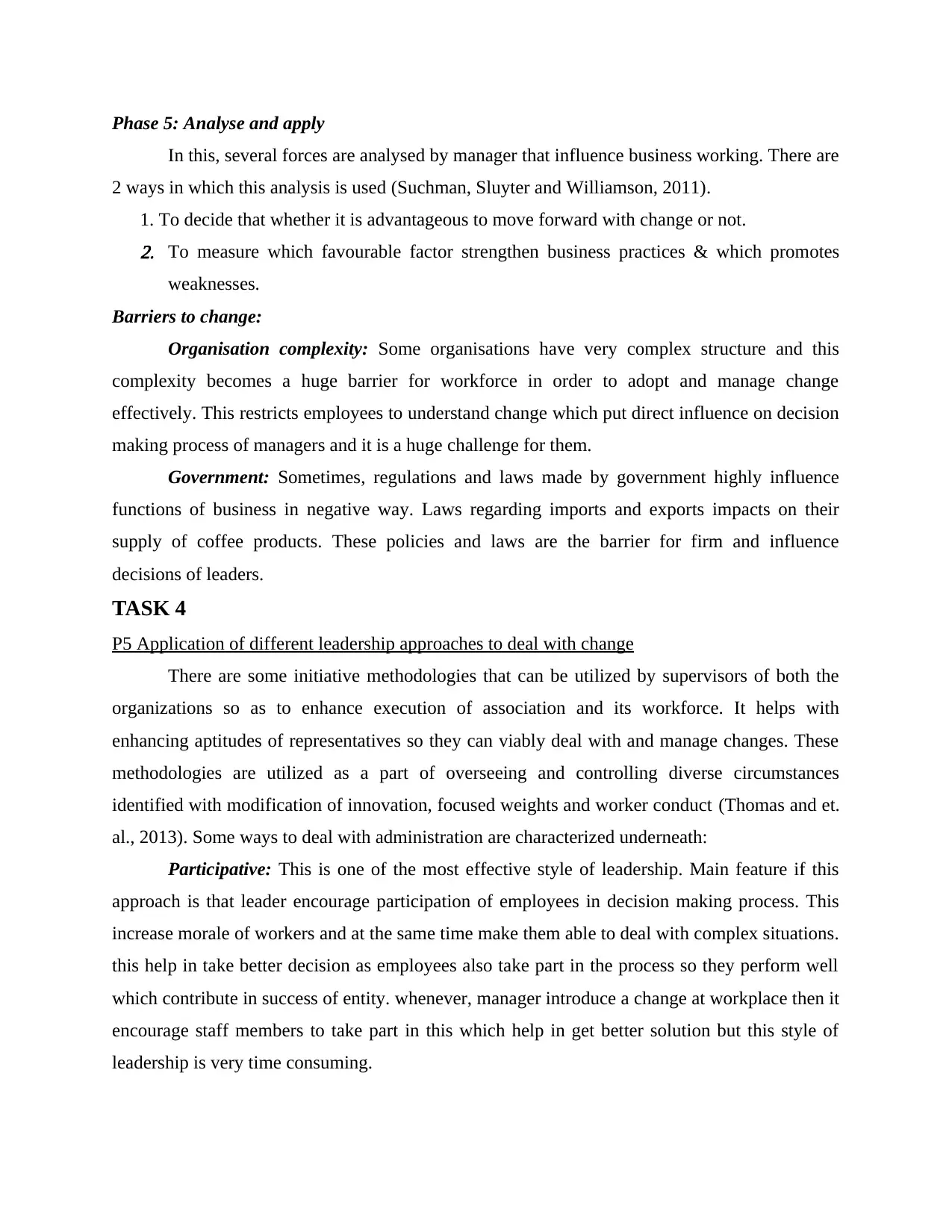
Phase 5: Analyse and apply
In this, several forces are analysed by manager that influence business working. There are
2 ways in which this analysis is used (Suchman, Sluyter and Williamson, 2011).
1. To decide that whether it is advantageous to move forward with change or not.2. To measure which favourable factor strengthen business practices & which promotes
weaknesses.
Barriers to change:
Organisation complexity: Some organisations have very complex structure and this
complexity becomes a huge barrier for workforce in order to adopt and manage change
effectively. This restricts employees to understand change which put direct influence on decision
making process of managers and it is a huge challenge for them.
Government: Sometimes, regulations and laws made by government highly influence
functions of business in negative way. Laws regarding imports and exports impacts on their
supply of coffee products. These policies and laws are the barrier for firm and influence
decisions of leaders.
TASK 4
P5 Application of different leadership approaches to deal with change
There are some initiative methodologies that can be utilized by supervisors of both the
organizations so as to enhance execution of association and its workforce. It helps with
enhancing aptitudes of representatives so they can viably deal with and manage changes. These
methodologies are utilized as a part of overseeing and controlling diverse circumstances
identified with modification of innovation, focused weights and worker conduct (Thomas and et.
al., 2013). Some ways to deal with administration are characterized underneath:
Participative: This is one of the most effective style of leadership. Main feature if this
approach is that leader encourage participation of employees in decision making process. This
increase morale of workers and at the same time make them able to deal with complex situations.
this help in take better decision as employees also take part in the process so they perform well
which contribute in success of entity. whenever, manager introduce a change at workplace then it
encourage staff members to take part in this which help in get better solution but this style of
leadership is very time consuming.
In this, several forces are analysed by manager that influence business working. There are
2 ways in which this analysis is used (Suchman, Sluyter and Williamson, 2011).
1. To decide that whether it is advantageous to move forward with change or not.2. To measure which favourable factor strengthen business practices & which promotes
weaknesses.
Barriers to change:
Organisation complexity: Some organisations have very complex structure and this
complexity becomes a huge barrier for workforce in order to adopt and manage change
effectively. This restricts employees to understand change which put direct influence on decision
making process of managers and it is a huge challenge for them.
Government: Sometimes, regulations and laws made by government highly influence
functions of business in negative way. Laws regarding imports and exports impacts on their
supply of coffee products. These policies and laws are the barrier for firm and influence
decisions of leaders.
TASK 4
P5 Application of different leadership approaches to deal with change
There are some initiative methodologies that can be utilized by supervisors of both the
organizations so as to enhance execution of association and its workforce. It helps with
enhancing aptitudes of representatives so they can viably deal with and manage changes. These
methodologies are utilized as a part of overseeing and controlling diverse circumstances
identified with modification of innovation, focused weights and worker conduct (Thomas and et.
al., 2013). Some ways to deal with administration are characterized underneath:
Participative: This is one of the most effective style of leadership. Main feature if this
approach is that leader encourage participation of employees in decision making process. This
increase morale of workers and at the same time make them able to deal with complex situations.
this help in take better decision as employees also take part in the process so they perform well
which contribute in success of entity. whenever, manager introduce a change at workplace then it
encourage staff members to take part in this which help in get better solution but this style of
leadership is very time consuming.
Paraphrase This Document
Need a fresh take? Get an instant paraphrase of this document with our AI Paraphraser
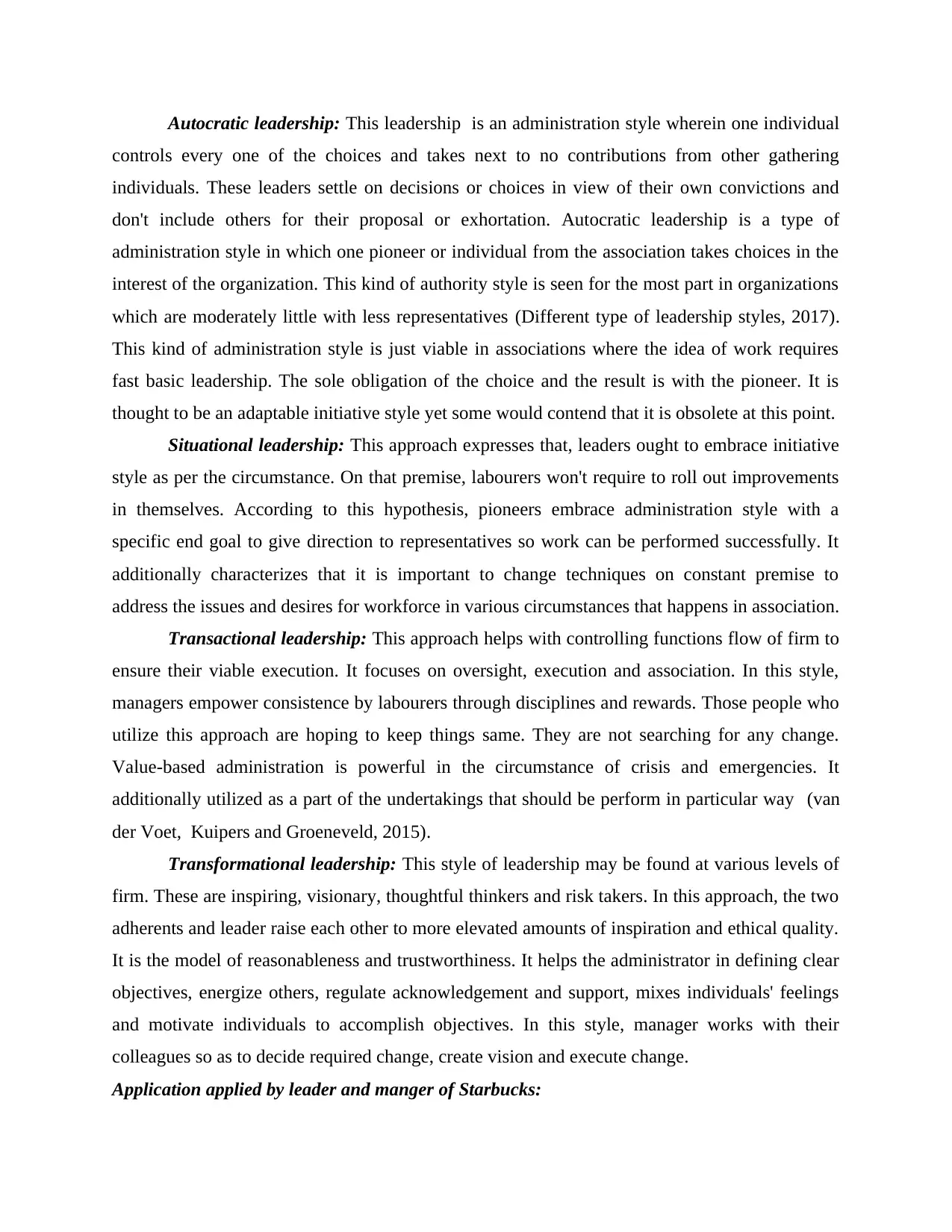
Autocratic leadership: This leadership is an administration style wherein one individual
controls every one of the choices and takes next to no contributions from other gathering
individuals. These leaders settle on decisions or choices in view of their own convictions and
don't include others for their proposal or exhortation. Autocratic leadership is a type of
administration style in which one pioneer or individual from the association takes choices in the
interest of the organization. This kind of authority style is seen for the most part in organizations
which are moderately little with less representatives (Different type of leadership styles, 2017).
This kind of administration style is just viable in associations where the idea of work requires
fast basic leadership. The sole obligation of the choice and the result is with the pioneer. It is
thought to be an adaptable initiative style yet some would contend that it is obsolete at this point.
Situational leadership: This approach expresses that, leaders ought to embrace initiative
style as per the circumstance. On that premise, labourers won't require to roll out improvements
in themselves. According to this hypothesis, pioneers embrace administration style with a
specific end goal to give direction to representatives so work can be performed successfully. It
additionally characterizes that it is important to change techniques on constant premise to
address the issues and desires for workforce in various circumstances that happens in association.
Transactional leadership: This approach helps with controlling functions flow of firm to
ensure their viable execution. It focuses on oversight, execution and association. In this style,
managers empower consistence by labourers through disciplines and rewards. Those people who
utilize this approach are hoping to keep things same. They are not searching for any change.
Value-based administration is powerful in the circumstance of crisis and emergencies. It
additionally utilized as a part of the undertakings that should be perform in particular way (van
der Voet, Kuipers and Groeneveld, 2015).
Transformational leadership: This style of leadership may be found at various levels of
firm. These are inspiring, visionary, thoughtful thinkers and risk takers. In this approach, the two
adherents and leader raise each other to more elevated amounts of inspiration and ethical quality.
It is the model of reasonableness and trustworthiness. It helps the administrator in defining clear
objectives, energize others, regulate acknowledgement and support, mixes individuals' feelings
and motivate individuals to accomplish objectives. In this style, manager works with their
colleagues so as to decide required change, create vision and execute change.
Application applied by leader and manger of Starbucks:
controls every one of the choices and takes next to no contributions from other gathering
individuals. These leaders settle on decisions or choices in view of their own convictions and
don't include others for their proposal or exhortation. Autocratic leadership is a type of
administration style in which one pioneer or individual from the association takes choices in the
interest of the organization. This kind of authority style is seen for the most part in organizations
which are moderately little with less representatives (Different type of leadership styles, 2017).
This kind of administration style is just viable in associations where the idea of work requires
fast basic leadership. The sole obligation of the choice and the result is with the pioneer. It is
thought to be an adaptable initiative style yet some would contend that it is obsolete at this point.
Situational leadership: This approach expresses that, leaders ought to embrace initiative
style as per the circumstance. On that premise, labourers won't require to roll out improvements
in themselves. According to this hypothesis, pioneers embrace administration style with a
specific end goal to give direction to representatives so work can be performed successfully. It
additionally characterizes that it is important to change techniques on constant premise to
address the issues and desires for workforce in various circumstances that happens in association.
Transactional leadership: This approach helps with controlling functions flow of firm to
ensure their viable execution. It focuses on oversight, execution and association. In this style,
managers empower consistence by labourers through disciplines and rewards. Those people who
utilize this approach are hoping to keep things same. They are not searching for any change.
Value-based administration is powerful in the circumstance of crisis and emergencies. It
additionally utilized as a part of the undertakings that should be perform in particular way (van
der Voet, Kuipers and Groeneveld, 2015).
Transformational leadership: This style of leadership may be found at various levels of
firm. These are inspiring, visionary, thoughtful thinkers and risk takers. In this approach, the two
adherents and leader raise each other to more elevated amounts of inspiration and ethical quality.
It is the model of reasonableness and trustworthiness. It helps the administrator in defining clear
objectives, energize others, regulate acknowledgement and support, mixes individuals' feelings
and motivate individuals to accomplish objectives. In this style, manager works with their
colleagues so as to decide required change, create vision and execute change.
Application applied by leader and manger of Starbucks:
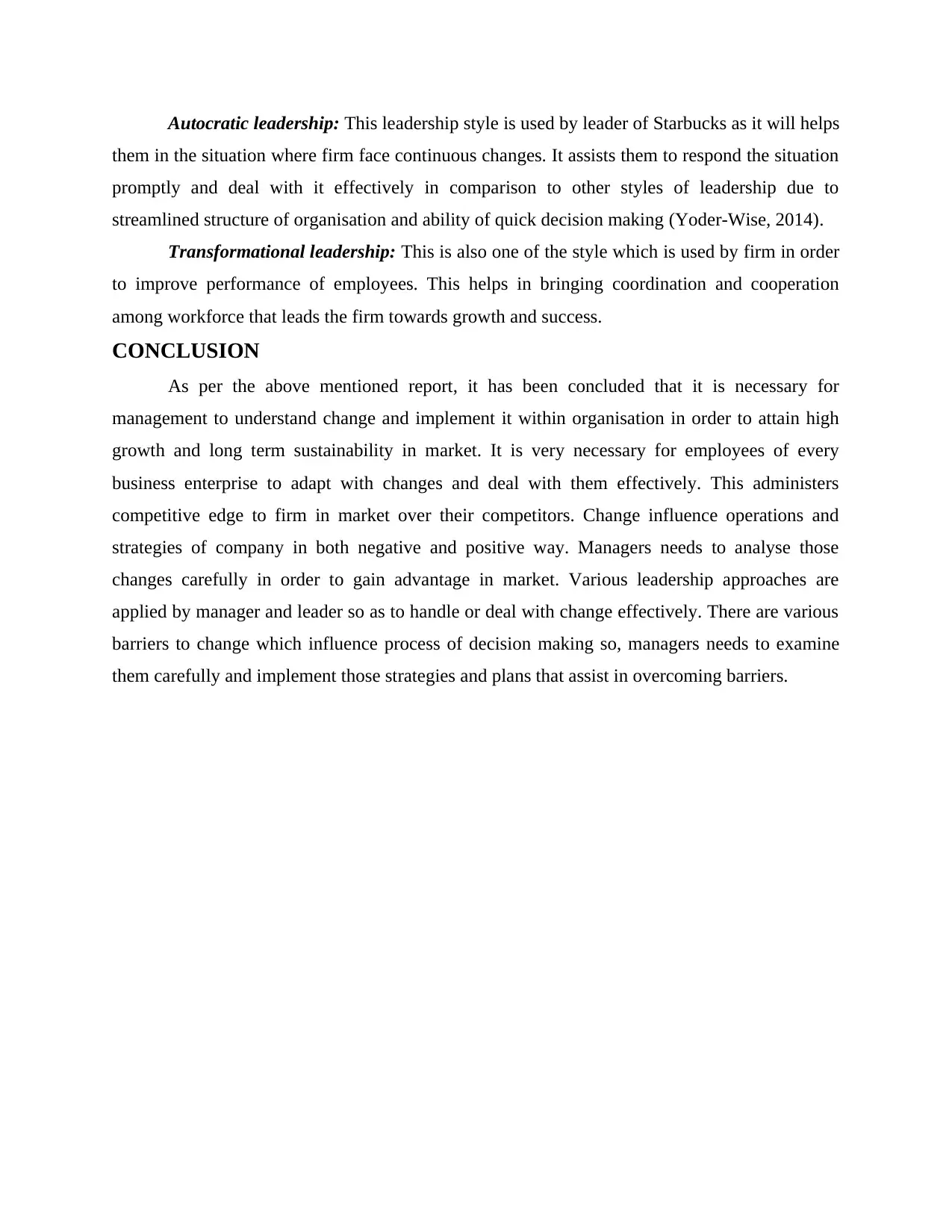
Autocratic leadership: This leadership style is used by leader of Starbucks as it will helps
them in the situation where firm face continuous changes. It assists them to respond the situation
promptly and deal with it effectively in comparison to other styles of leadership due to
streamlined structure of organisation and ability of quick decision making (Yoder-Wise, 2014).
Transformational leadership: This is also one of the style which is used by firm in order
to improve performance of employees. This helps in bringing coordination and cooperation
among workforce that leads the firm towards growth and success.
CONCLUSION
As per the above mentioned report, it has been concluded that it is necessary for
management to understand change and implement it within organisation in order to attain high
growth and long term sustainability in market. It is very necessary for employees of every
business enterprise to adapt with changes and deal with them effectively. This administers
competitive edge to firm in market over their competitors. Change influence operations and
strategies of company in both negative and positive way. Managers needs to analyse those
changes carefully in order to gain advantage in market. Various leadership approaches are
applied by manager and leader so as to handle or deal with change effectively. There are various
barriers to change which influence process of decision making so, managers needs to examine
them carefully and implement those strategies and plans that assist in overcoming barriers.
them in the situation where firm face continuous changes. It assists them to respond the situation
promptly and deal with it effectively in comparison to other styles of leadership due to
streamlined structure of organisation and ability of quick decision making (Yoder-Wise, 2014).
Transformational leadership: This is also one of the style which is used by firm in order
to improve performance of employees. This helps in bringing coordination and cooperation
among workforce that leads the firm towards growth and success.
CONCLUSION
As per the above mentioned report, it has been concluded that it is necessary for
management to understand change and implement it within organisation in order to attain high
growth and long term sustainability in market. It is very necessary for employees of every
business enterprise to adapt with changes and deal with them effectively. This administers
competitive edge to firm in market over their competitors. Change influence operations and
strategies of company in both negative and positive way. Managers needs to analyse those
changes carefully in order to gain advantage in market. Various leadership approaches are
applied by manager and leader so as to handle or deal with change effectively. There are various
barriers to change which influence process of decision making so, managers needs to examine
them carefully and implement those strategies and plans that assist in overcoming barriers.
⊘ This is a preview!⊘
Do you want full access?
Subscribe today to unlock all pages.

Trusted by 1+ million students worldwide
1 out of 14
Related Documents
Your All-in-One AI-Powered Toolkit for Academic Success.
+13062052269
info@desklib.com
Available 24*7 on WhatsApp / Email
![[object Object]](/_next/static/media/star-bottom.7253800d.svg)
Unlock your academic potential
Copyright © 2020–2025 A2Z Services. All Rights Reserved. Developed and managed by ZUCOL.





